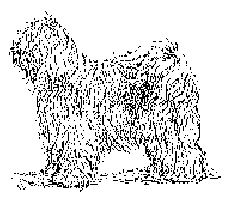Tibetan Terrier
General Information - Tibetan Terrier

Group:
Non
Sporting
Size:
Medium
Lifespan:
12-15 years
Exercise:
Medium
Grooming:
High
Trainability:
Medium
Watchdog Ability:
High
Protection Ability:
Very low
Area of Origin:
Tibet
Date of Origin:
Ancient times
Other Names:
Dhokhi Apso
Original Function:
Herder, good luck
charm, companion
History
The Tibetan Terrier, also known as the Dhokhi Apso, is an ancient breed that dates back to the Middle Ages. It originates from the rugged terrain and climate of Tibet where it was used to herd stock and to guard, amongst other duties, but not as a Terrier. It was kept by the monks as well in monasteries and considered a treasured gift. It is one of the relatives of the Lhasa Apso, the Shih Tzu, and the Tibetan Spaniel. The breed was first introduced to Europe in the 1930s where it became a companion dog.
Temperament
This little companion dog loves people. Tibetan Terriers are lively and outgoing and were once kept and treasured in Tibetan monasteries. Affectionate and lively, the friendly Tibetan Terrier dog breed is somewhat reserved around strangers. A Tibetan Terrier's bark is unique in the way it raises in pitch and volume as it continues to bark.
Upkeep
The Tibetan Terrier likes to run and explore, and needs daily exercise in a safe area. Its needs can also be met by a vigorous game in the yard or a moderately long walk on leash. Although capable of living outdoors in temperate or modestly cool climates, it is better as an indoor, or indoor/outdoor, dog. Its long coat needs thorough brushing or combing once or twice a week.
Tibetan Terrier
A breed standard is the guideline which describes the ideal characteristics, temperament, and appearance of a breed and ensures that the breed is fit for function with soundness essential. Breeders and judges should at all times be careful to avoid obvious conditions and exaggerations, as well as being mindful of features which could be detrimental in any way to the health, welfare or soundness of this breed.
Breed Standard - Tibetan Terrier

Characteristics: Alert, intelligent and game, not fierce nor pugnacious. Chary of strangers.
General Appearance: A well muscled medium sized dog, in general appearance not unlike an Old English Sheepdog in miniature.
Head And
Skull: Skull of medium length, not broad or coarse, narrowing slightly from ear to eye, not domed but not absolutely flat between the ears. The malar bones are curved, but should not be over developed so as to bulge. There should be a marked stop in front of the eyes, but this must not be exaggerated. The head should be well furnished with long hair, falling forward over the eyes. The lower jaw should carry a small, but not exaggerated, amount of beard. The length from eye to tip of nose equal to length from eye to base of skull; not broad nor massive. Nose black.
Eyes: Large, dark, neither prominent nor sunken; should be set fairly wide apart. Eyelids dark.
Ears: Pendant, not too close to head, V:shaped, not too large, heavily feathered.
Mouth: Level by preference but if slightly undershot not to be penalised.
Forequarters: Legs parallel and heavily furnished. Pasterns slightly sloping.
Body: Compact and powerful. Length from point of shoulder to root of tail equal to height at withers. Well ribbed up. Loin slightly arched.
Hindquarters: Heavily furnished, should be slightly longer than forelegs with well bent stifles and low set hocks giving a level back.
Feet: The feet should be large, round, heavily furnished with hair between the toes and pads. The dogs should stand well down on its pads. There should be no arch in the feet.
Gait: When walking or trotting the hind legs should neither go inside nor outside the front ones but run on the same track.
Tail: Medium length, set on fairly high and carried in a gay curl over the back. Very well feathered. There is often a kink near the tip.
Coat: Double coated. The undercoat fine wool, the top coat profuse, fine but not silky or woolly; long; either straight or waved.
Colour: White, golden, cream, grey or smoke, black, parti:coloured, and tri:colours; in fact any colour except chocolate or liver colour.
Size: Height at shoulders, dogs should be from 35.6 to 40.6 cm (14:16 in), bitches slightly smaller.
Faults: A weak snipy foreface should be penalised. Lack of double coat. Cat feet.
Note: Male animals should have two apparently normal testicles fully descended into the scrotum.
[NZKC No 799
[FCI No 209
Any departure from the foregoing points should be considered a fault and the seriousness with which the fault should be regarded should be in exact proportion to its degree and its effect upon the health and welfare of the dog and on the dog’s ability to perform its traditional work.




